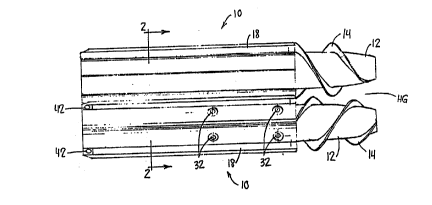Une partie des informations de ce site Web a été fournie par des sources externes. Le gouvernement du Canada n'assume aucune responsabilité concernant la précision, l'actualité ou la fiabilité des informations fournies par les sources externes. Les utilisateurs qui désirent employer cette information devraient consulter directement la source des informations. Le contenu fourni par les sources externes n'est pas assujetti aux exigences sur les langues officielles, la protection des renseignements personnels et l'accessibilité.
L'apparition de différences dans le texte et l'image des Revendications et de l'Abrégé dépend du moment auquel le document est publié. Les textes des Revendications et de l'Abrégé sont affichés :
| (12) Brevet: | (11) CA 2123294 |
|---|---|
| (54) Titre français: | ERAFLOIR A BORDS TRANCHANTS |
| (54) Titre anglais: | KNIFE EDGED STALK ROLLS |
| Statut: | Périmé |
| (51) Classification internationale des brevets (CIB): |
|
|---|---|
| (72) Inventeurs : |
|
| (73) Titulaires : |
|
| (71) Demandeurs : | |
| (74) Agent: | BORDEN LADNER GERVAIS LLP |
| (74) Co-agent: | |
| (45) Délivré: | 1997-10-07 |
| (22) Date de dépôt: | 1994-05-10 |
| (41) Mise à la disponibilité du public: | 1994-11-12 |
| Requête d'examen: | 1994-05-10 |
| Licence disponible: | S.O. |
| (25) Langue des documents déposés: | Anglais |
| Traité de coopération en matière de brevets (PCT): | Non |
|---|
| (30) Données de priorité de la demande: | ||||||
|---|---|---|---|---|---|---|
|
Rouleau broyeur de tiges constitué d'un corps cylindrique ayant six cannelures incorporées. Chaque cannelure comporte un tranchant ayant une surface d'attaque et une surface de fuite. La surface d'attaque comporte une pente vers l'avant d'environ 10° par rapport au plan formé par l'axe longitudinal central du corps cylindrique et le sommet du tranchant respectif. La surface de fuite comporte une pente inverse d'environ 30° par rapport au plan formé par l'axe longitudinal central du corps cylindrique et le sommet du tranchant respectif. Le corps cylindrique comprend deux pièces semi-cylindriques qui sont fixées de part et d'autre de l'arbre d'entraînement d'une récolteuse d'épis de maïs à l'aide de boulons connexes.
A stalk roll comprises a cylindrical shell having six
integral flutes. Each flute is provided with a knife edge
having a leading surface and a trailing surface. The leading
surface has a forward slope of approximately 10~ from the
plane formed by the central longitudinal axis of the
cylindrical shell and the vertex of the respective knife edge.
The trailing surface has a reverse slope of approximately 30~
from the plane formed by the central longitudinal axis of the
cylindrical shell and the vertex of the respective knife edge.
The cylindrical shell comprises two semi-cylindrical pieces
that are clamped about a drive shaft of a corn harvesting head
by associated bolts.
Note : Les revendications sont présentées dans la langue officielle dans laquelle elles ont été soumises.
Note : Les descriptions sont présentées dans la langue officielle dans laquelle elles ont été soumises.

Pour une meilleure compréhension de l'état de la demande ou brevet qui figure sur cette page, la rubrique Mise en garde , et les descriptions de Brevet , États administratifs , Taxes périodiques et Historique des paiements devraient être consultées.
| Titre | Date |
|---|---|
| Date de délivrance prévu | 1997-10-07 |
| (22) Dépôt | 1994-05-10 |
| Requête d'examen | 1994-05-10 |
| (41) Mise à la disponibilité du public | 1994-11-12 |
| (45) Délivré | 1997-10-07 |
| Expiré | 2014-05-12 |
Il n'y a pas d'historique d'abandonnement
Les titulaires actuels et antérieures au dossier sont affichés en ordre alphabétique.
| Titulaires actuels au dossier |
|---|
| DEERE & COMPANY |
| Titulaires antérieures au dossier |
|---|
| ADAMS, BONNIE D. |
| CHRISTENSEN, TIMOTHY F. |
| SANDAU, JERRY ALAN |